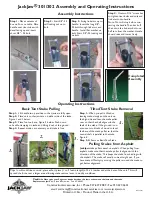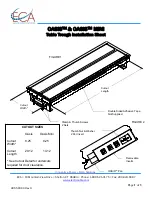
Adjusting the Conditioner Rolls – Standard Headers
Roll Gap
Roll Tension
Increase conditioning:
1.
Loosen jam nut (A) on both sides of the conditioner.
2.
Turn lower nut (B) counterclockwise to decrease roll gap (C).
3.
Tighten jam nut (A) on both sides of the conditioner.
Decrease conditioning:
1.
Loosen jam nut (A) on both sides of the conditioner.
2.
Turn lower nut (B) clockwise to increase roll gap (C).
3.
Tighten jam nut (A) on both sides of the conditioner.
IMPORTANT: Ensure the nuts are adjusted equally on both sides of the
Decrease tension (light crops):
1.
Loosen jam nut (A) on both sides of the conditioner.
2.
Turn bolt (B) counterclockwise to increase exposed thread (C)
equally on both sides of the conditioner.
3.
Tighten jam nut (A) on both sides of the conditioner.
Increase tension (heavy or tough crops):
1.
Loosen jam nut (A) on both sides of the conditioner.
2.
Turn bolt (B) clockwise to decrease exposed thread (C) equally on
both sides of the conditioner.
3.
Tighten jam nut (A) on both sides of the conditioner.
Setting the Float – Standard and Grass Seed
For instructions on setting and adjusting the header float, refer to your windrower operator’s manual.
The header float feature allows the header to closely follow ground contours and respond quickly to sudden changes or obstacles. The float setting is
ideal when the cutterbar is on the ground with minimal bouncing, scooping, or pushing soil.
IMPORTANT:
Set the header float as light as possible—without excessive bouncing—to avoid frequent breakage of knife components, scooping soil, or
soil build-up at the cutterbar in wet conditions.
When the float setting is light, operate at a slower ground speed to avoid excessive bouncing (resulting in a ragged cut).
Install the applicable header options (crop dividers, etc.) before setting the header float.
Adjust the float when adding or removing optional attachments that affect the weight of the header.
Changing the header angle affects the float. Check the float after making appropriate changes to the header angle for crop type and
conditions, field conditions, and speed settings.
Adjusting Cutting Height – Standard and Grass Seed
Header Angle
Skid Shoes
Shallow Angle
Steep Angle
Intermediate Positions
Lower Position
Use a shallow angle when the
ground is rocky, ridged, loose, or
uneven.
Use a steep angle when the ground
is firm, level, or smooth.
Use the intermediate positions (A)
when the ground is smooth, or to
produce a short stubble.
Use the lower position when the
ground is uneven, or to produce a
high stubble.
Grass Seed (GSS) Operation
Hazard/Brake Lights – Field Mode
Transport Mode
Before operating in the field:
Rotate hazard/brake lights (A) toward the front of the header.
Before transporting the header:
Rotate hazard/brake lights (A) outward.
Anti-Shatter Shield
Drum Speed and Position
To operate in the field:
FULLY extend (A) or retract (C) anti-shatter shield, depending
on the type of crop.
FULLY extend (A) the shield by pressing F5 (B) on the operator
console until the baffle position on the Harvest Performance
Tracker (HPT) is “10”.
FULLY retract (C) the shield by pressing F6 (D) on the operator
console until the baffle position on the HPT is “0”.
IMPORTANT: Do NOT operate the header in the field with the
baffle position set to 1–9 for any purpose.
To prepare for transport:
FULLY retract (C) the shield by pressing F6 (D) on the operator
console until the baffle position on the HPT is “0”.
IMPORTANT: Do NOT transport the header with the baffle
position set to 1–10 for any purpose.
Adjust the drum speed and height as desired using the ground speed
lever (GSL) or the operator’s console:
To widen the windrow, press REEL UP (A) switch on the GSL, or
button (A) on the operator’s console.
To increase the drum speed, press switch (C) on the GSL, or
button (C) on the operator’s console.
To decrease the drum speed, press switch (D) on the GSL, or
button (D) on the operator’s console.
Drum speed range is 235–705 rpm. Monitor the drum speed
using Run Screen 2 on the Harvest Performance Tracker (HPT).




















